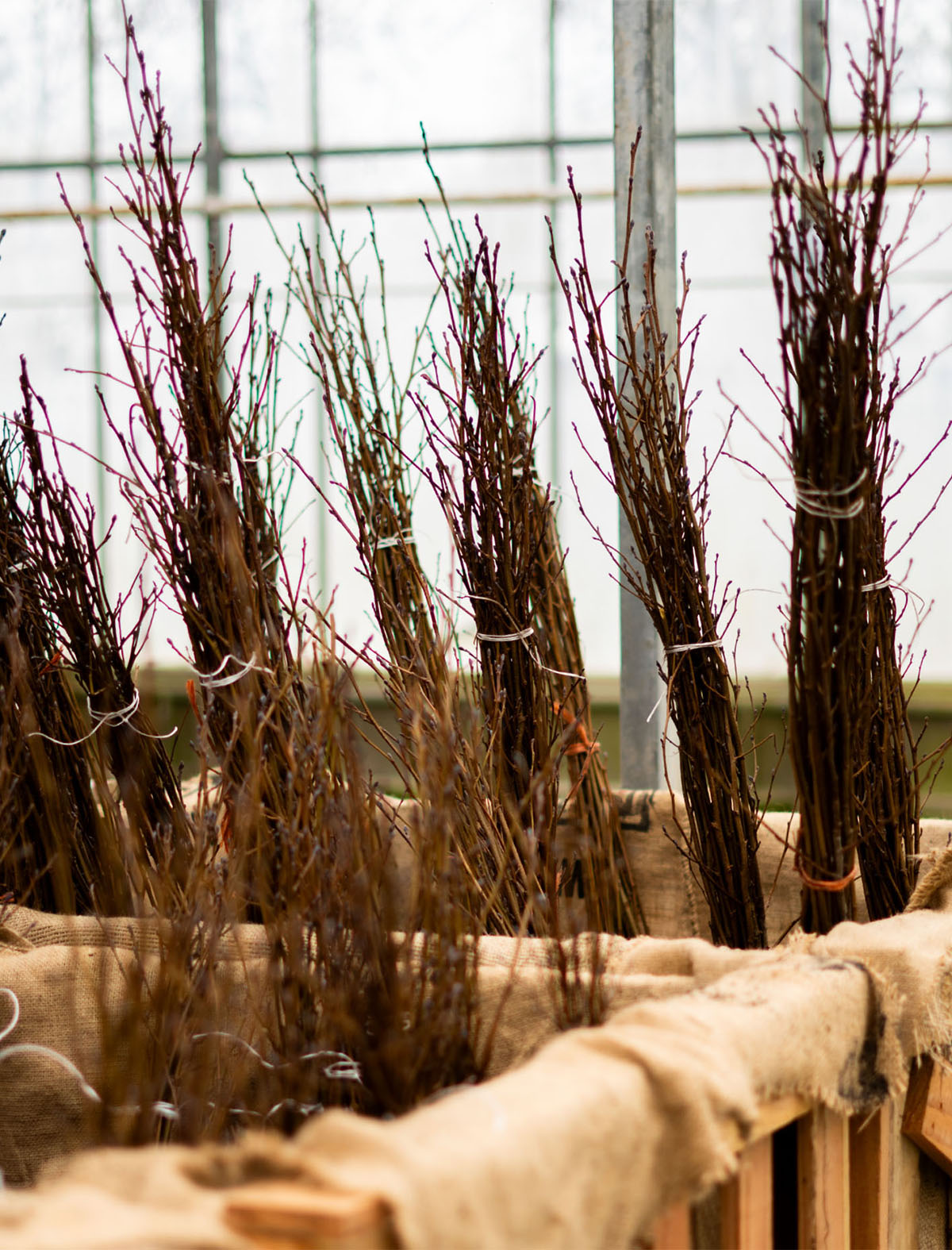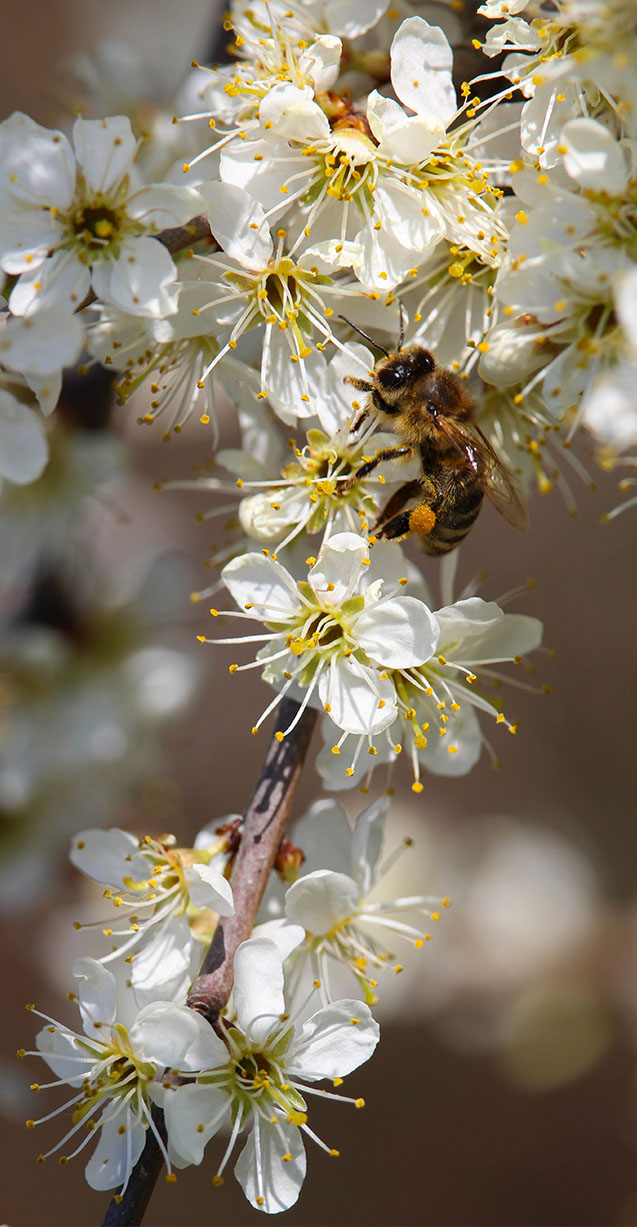The environmental benefits of bare root hedging
How native hedges support biodiversity, reduce carbon impact, and enhance sustainable landscapes.
The bare root season, which usually occurs between November and March, is a staple of the UK landscaping industry, providing a valuable opportunity to plant hedges at scale for a fraction of the usual cost. Unlike containerised or root ball plants, bare root hedging is more affordable, lighter to transport, and is quicker to establish once planted. However, the benefits aren’t just limited to cost and efficiency. For landscapers, well-planned UK native hedgerows in particular can deliver lasting gains for biodiversity, climate resilience, and native wildlife.
What is bare-root hedging?
Bare root native hedging refers to trees or shrubs lifted from the nursery field while dormant, with soil removed from their roots and planted directly into the ground. Because they are lifted and handled while dormant, bare root plants tend to recover faster than containerised stock, with less transplant shock. Using native species ensures that the hedge aligns with local ecology, soils, and wildlife communities.
During the winter, many deciduous plants enter a period of dormancy where growth slows, energy is stored within the roots, and the plant temporarily stops drawing in water and nutrients. This natural resting phase makes it possible to lift plants from the soil with minimal stress. The fine root hairs that absorb nutrients die back, leaving stronger structural roots that are less sensitive to disturbance. When these plants are dug up and transported as bare root, they experience little damage and can be replanted safely before spring growth begins. Once in the ground, new root hairs quickly form, allowing the plant to establish itself efficiently in its new environment. This seasonal cycle is what makes bare root planting such a reliable and successful method for large-scale landscape planting.
Because bare root plants omit heavy containers, soil, or root balls, the energy and materials required in their production are significantly lower. Transport is also more efficient, as lighter loads and compact bundling allow for fewer lorry movements compared to bulky containers. All this helps reduce the cost and environmental impact of the planting.

Benefits of native bare root hedging
Cost
Bare root plants are a cost-effective option for both large-scale and small planting projects. Whilst they are only available during the winter months, because they are grown in open ground and lifted during dormancy, they require less labour, packaging, and growing media than container plants. This makes them significantly cheaper to produce and transport, sometimes a third of the price of their containerised equivalents, allowing landscapers and developers to establish large areas of planting within budget. Their affordability also supports large biodiversity projects, where the volume of plants is often a deciding factor in achieving ecological impact. This is why, with careful planning, the bare root season can provide a prime opportunity for landscapers to make a significant saving on the cost of hedgerow plants and native trees.
Carbon footprint
Bare root hedging is a more environmentally responsible choice compared to container-grown plants, particularly when considering the full lifecycle from production to planting. The cultivation of bare root plants requires fewer inputs. They are grown directly in the ground outside in the field, and lifted during their dormant season, which means there is no need for plastic pots, compost, or artificial irrigation. This method significantly reduces the use of water, fertilisers, and energy. The approximate carbon footprint of a single bare root tree is 0.13 Kg of Co₂e, whereas the average container grown plant in a green is around 0.8kg Co₂e. Over the course of a season, during which Greenwood can sell upwards of half a million bare root plants, this adds up to a considerable carbon footprint reduction.
Transporting bare root plants is also more efficient. Because they are lighter and more compact, more plants can be moved in a single delivery. For example, 500 bare root hawthorn (Crataegus monogyna) plants weigh less than 25 kilograms, while the same number in 2-litre pots would weigh close to a tonne. This difference allows nurseries to ship large quantities with fewer journeys, cutting down on fuel use and greenhouse gas emissions. Another benefit is the absence of plastic waste. Container-grown plants rely heavily on plastic pots, which often end up in landfill unless properly recycled. Bare root plants are shipped without pots, helping to reduce plastic pollution and supporting efforts to phase out single-use plastics in horticulture.
Once planted, native hedgerows contribute to carbon storage in the landscape. Research from the University of Leeds shows that soil beneath hedgerows stores around 40 percent more carbon than adjacent grassland. This makes hedgerow planting a valuable tool in climate mitigation strategies. The UK government has recognised the role of hedgerows in carbon reduction and biodiversity enhancement. It has set a target to plant 72,500 kilometres of new hedgerows by 2050, aiming to increase the national hedge network by 40 percent. Choosing bare root plants supports these goals by enabling large-scale planting with minimal environmental impact.

Honey bee on a branch of Prunus spinosa
Wildlife
Native hedgerows are essential habitats for British wildlife. They support a wide variety of species, including birds, bees, butterflies, and small mammals by offering food, shelter, and safe passage throughout the year. These benefits go beyond biodiversity targets and contribute directly to the health and resilience of local wildlife.
In spring and summer, flowering hedgerow species such as hawthorn (Crataegus monogyna), blackthorn (Prunus spinosa), and dog rose (Rosa canina) attract pollinators like bees and hoverflies, providing nectar and pollen when other sources may be scarce. As the seasons progress, berries and nuts become a vital food source for birds such as blackbirds, thrushes, and finches, while mammals like dormice and hedgehogs forage among the undergrowth. Evergreen species like holly (Ilex aquifolium), whilst normally sold as rootballs during the planting season, continue to offer shelter and sustenance during the winter months, helping wildlife survive colder conditions.
Hedgerows also provide safe nesting sites and protection from predators. Their dense structure, especially when made up of thorny species, creates a secure environment for birds to raise their young and for small mammals to hide from threats. The base of a hedgerow is often used by hedgehogs and voles for nesting and hibernation, while the upper branches support birds and insects.
One of the most important roles hedgerows play is as wildlife corridors. These green pathways allow animals to move safely between habitats, helping them find food, mates, and shelter without crossing open fields or roads. This connectivity is especially important in modern landscapes, where development and intensive agriculture have fragmented natural habitats. Bats use hedgerows as flight routes between roosts and feeding areas, while butterflies and bees benefit from the continuous supply of nectar and shelter along the way.
Bare root hedging is particularly well suited to creating these corridors quickly and cost-effectively. Because it can be planted in large numbers with minimal environmental impact, it supports landscape-scale efforts to reconnect habitats and improve conditions for wildlife. This makes it a practical and choice for commercial landscaping projects that aim to enhance biodiversity and support native species.
Biodiversity Net Gain
Biodiversity Net Gain (BNG) is now a statutory requirement in England under the Environment Act 2021. New developments must now contain within their plans a biodiversity gain of at least 10% relative to the pre-development baseline, using the statutory biodiversity metric to calculate ‘biodiversity units’. Under the metric, hedgerows are treated as a habitat category. The value of a hedge depends on its length, condition, distinctiveness, and connectivity, among other factors. Because native hedgerows score well in condition, distinctiveness, and connectivity, they tend to produce higher units per metre than low-value habitats like species-poor grassland. Enhancing or creating native hedges can therefore be a highly efficient means of delivering BNG in new developments. In a development example in Essex, creating and enhancing hedgerows generated a net gain of 180% in hedge biodiversity units, thanks to the high value of well-connected, native hedgerow habitat. Because hedgerows often deliver multiple ecosystem services (shade, wind protection, carbon storage, soil stabilisation), they can deliver on climate and biodiversity goals simultaneously.
Five native hedge plants we recommend
Here are five native hedging species widely used in the UK, well suited to bare-root planting and environmental benefit:
Carpinus betulus (Hornbeam)
Hornbeam forms dense foliage, including retention of some dead leaves through winter when young (making a more made hedge-like look). It performs well in heavier soils and is tolerant of trimming. Hornbeam supports many invertebrate species and is good for structural hedge form.
Crataegus monogyna (Hawthorn)
A classic hedge species, forming dense, thorny growth ideal for wildlife. In spring it flowers abundantly, feeding bees and insects; in late summer it produces berries (haws) that feed birds. Tolerates a broad range of soil types and has strong regenerative ability after cutting.

Carpinus betulus

Crataegus monogyna
Prunus spinosa (Blackthorn)
Often used in mixed native hedges, blackthorn produces fragrant spring blossom followed by sloes in autumn. Its dense growth and thorns offer protection for nesting birds. It thrives in chalky and clay soils and is vigorous in bare-root hedging.
Corylus avellana (Hazel)
Hazel offers multiple benefits: early catkins are one of the first pollen sources in spring, nuts are food for mammals, and its branching habit adds structure. It grows well in many soils and responds to coppicing, making it useful in layered hedges.
Acer campestre (Field Maple)
Field maple is a smaller tree within a hedge, adding seasonal interest with its foliage in autumn. It tolerates shade and urban conditions well. When planted within a row, it adds vertical structure, leaf colour, and connectivity to woodland species.

Acer campestre
Practical tips: specification, planting & establishment
Bare root hedging should be planted during its dormant season, typically from November to March, with plants spaced 30–40 cm apart in a double staggered row to encourage density. Before planting, it’s important to clear weeds and lightly cultivate the soil, adding organic matter if needed. When planting, roots should be spread out and positioned so the root collar sits level with the soil surface, then gently firmed to remove air pockets. A thorough watering after planting helps during dry spells, and applying a visible mulch like woodchip helps retain moisture and suppress weeds. In the first few years, light formative trimming encourages bushier growth, and maintaining a weed-free zone around the base supports establishment. For Biodiversity Net Gain, it’s essential to monitor hedge condition, reduce gaps, maintain connectivity, and keep records of management activities such as pruning and trimming to demonstrate long-term health.
Bare-root native hedging is a highly sustainable, biodiversity-rich planting solution. Its lower energy and transport footprint, alignment with native ecology, and strong performance under the UK’s Biodiversity Net Gain framework all make it an ideal choice for public and commercial landscapes.
With care in establishment and ongoing management, these native hedgerows will provide benefits for many years to come.
If you’d like more information on the native bare root hedges we sell, speak to the G Team today.

